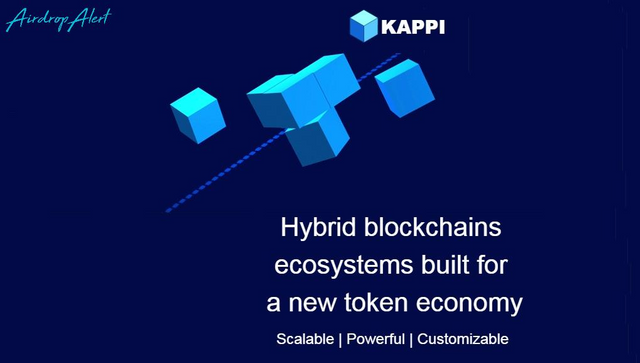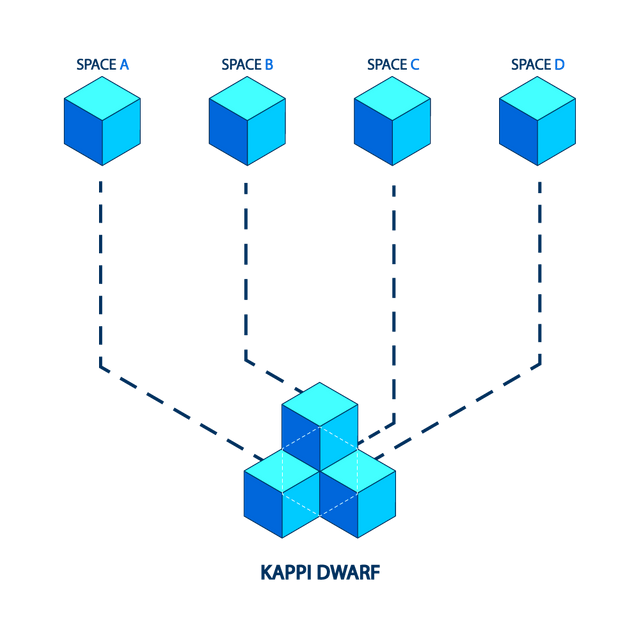
Introduction
KAPPI is a network of independent and decentralized hybrid blockchains. They help to solve many problems of the existing blockchains like scalability, TPS, usability, security. sovereignty.
Creating success through the use of decentralized file-sharing in an open-source ecosystem to run a public cryptocurrency has allowed more people to understand how such infrastructure can improve basic social economics. Bitcoin, and Zero cash are two examples of specialized blockchain applications, and the best example of a smart contract platform would still be Ethereum, which allows for many applications of the Ethereum Virtual Machine (EVM).
There have been drawbacks to the different blockchains that have been created thus far, such as the lack of energy efficiency, lack of any type of well thought out governance mechanisms and limited or poorly performing blockchains. Scalability was not thought of when Bitcoin was incepted, and now there are proposals to create scalability throughout Bitcoin’s transaction process. These include Bitcoin and Segregated-Witness, which are both vertical scaling models which are still bound by a lack of capacity within any single machine.
This approach is necessary for pre-existing blockchains that didn’t consider their scalability due to the requirement to maintain a complete auditability. There is also the Lighting Network, which could be used instead of alternative options to bring scalability to Bitcoin transaction volume.
This would be accomplished in the Lightning Network by reducing the number of transactions that are on the ledger. This approach is suitable for privacypreserving payment rails and for micropayments but might not suit more generalized scaling requirements. Multiple blockchains running in parallel could use this solution advantageously, allowing for interoperation and still keeping all security properties of the blockchain.
Proof-of-work approaches make this all but impossible. For merged mining, work is allowed to be done for the securing of a parent chain to be used again on a child chain but does not take away the need for each individual transaction to be validated by each node in order. Merged mined blockchains are also open to attack from a hashtag power majority on the parent chain, where there is no active merging of the child chain. This is where KAPPI comes in. KAPPI is a unique blockchain which has network architecture that addresses each of the above problems.
Why Kappi?
Kappi solved many problems from the existing blockchain:
- Scalability
- TPS
- Use
- Security
- Sovereignt
KAPPI is able to decipher the blockchain design through offering an easy API that functions between the consensus process and the application process. KAPPI consists of parallel blockchain networks which are all supported independently by classic BFT consensus algorithms such as KAPPI. The first blockchain in the network is KAPPI DWARF, which is connected to several zones or other blockchains through a unique inter-blockchain communication protocol. KAPPI DWARF can track many types of tokens and stores all tokens in each connected zone.
Tokens can be transferred from one zone to another quickly and safely without the need for physical fluid exchange between zones. This is possible due to the fact that all coin transfers are made between Zones will all go through KAPPI DWARF, which acts as a solution to many of the problems faced by the blockchain in contemporary times.

Some problems are solved using this architecture, including issues of scalability, interoperability, and flawless enhancements. Regardless of where the zone originates, including if it was created on Bitcoin, CryptoNote, Go-Ethereum or Cash, among others, it can be plugged into KAPPI DWARF. This allows unlimited scalability to the future and shows that this zone is perfect for operating distributed exchanges. KAPPI is not just a distributed ledger, but instead creates a protocol for each distributed exchange network. Transparency, a healthy economy, accountability theory and consensus are all included. KAPPI validators operate the same as miners in Bitcoin, except that it uses cryptographic signatures to vote.
KAPPI Consensus Protocol
The KAPPI consensus protocol and the interface which was used to build the application is backed by nodes which retain voting power which is no-negative. This is different than the classic Byzantine Fault Tolerant (BFT) algorithm that has each node carrying the same weight. In the KAPPI consensus, validators are able to participate in the consensus protocol through broadcasting cryptographic
based signatures, which are referred to as votes, that agree on the next block. The voting power of each validator is determined at genesis and can be altered deterministically within the blockchain, which would be dependent on what the application is. An example of this is that the staking tokens can be bonded as collateral to determine the voting power. Unless all the validators have an equal
weight, fractions would not be used to refer to the validator but only for the total voting power.
An analogy can be made with Bitcoin, which is known as a cryptocurrency blockchain that operates by having each node carrying a fully audited Unspent Transaction Output (UTXO) database. If someone wished to create that type of system on an ABCI foundation the KAPPI DWARF would have the responsibility to share transactions and blocks between each node. This would establish an
immutable or canonical order to the transactions in the blockchain.
The ABCI application would maintain the responsibility for:
- The UTXO database.
- Validating all cryptographic signatures within a transaction.
- Stopping transactions from spending funds which do not exist.
- Allowing client query through the UTXO database.
Scalability and Decentralization
KAPPI is comprised of a network of many blockchains that being powered by KAPPI. KAPPI allows many blockchains to be running concurrently with each other whilst retaining interoperability.
At its DWARF, KAPPI DWARF manages multiple independent blockchain ‘zones’, that are also referred to by some as shards. With a constant stream of block commits coming from zones on the DWARF, it can keep up with each zone’s information and its current state.
In turn, the zones keep up with the DWARF, but not each other except through the DWARF. Information packets are sent from one zon to another through the DWARF through Merkle-proof posting showing that the information was both sent and received accurately.
- Scalability
- High performance
- Secure
- Hybrid blockchain
- Can be adjusted
- Easy integration
Distribution Token

- 35%: Personal sales
- 20%: Public Sales
- 20%: Team
- 10%: platform development fund
- 10%: Play swap burn
- 5%: Bounty
Roadmap
Mar 2018
Blockchain research
August 2018
Initial coding, draft whitepaper
December 2018
Prospective investor meetings
May 2019
Kappi Network LTD was formed
Jun 2019
Personal Sales
August 2019
Distribution registration
Sep 2019
Public sales
February 2020
Testnet 1.0 (Red Dwarf) lives
May 2020
Testnet 2.0 (White Dwarf) lives
Jul 2020
Mainnet (Polymorph) lives
Nov 2020
Mainnet swap
Feb 2021
Kappi Network blockchain licensing
May 2021
Mainstream adoption through licensing sales
Meet Our Team

Daniel Jonsson
Founding father
Anna Lanonen
Development of Project Leaders

- Miguela Webster
Network Architect

- Anna Ketola
The developer

- Saad Sher
The developer

- David Attard
Graphic designer
For more clear information please visit the link below:
Website: – https://kappi.network/
Twitter: – https://twitter.com/kappinetwork
Reddit: – https://www.reddit.com/r/KappiNetwork/
Linkedin: – https://www.linkedin.com/company/kappinetwork/about/
Steemit: –
BitcoinTalk: – https://bitcointalk.org/index.php?topic=5182251.0
Github: – https://github.com/kappinetwork
Telegram Community Group: – https://t.me/kappi_network
Bounty Group: – https://t.me/kappi_bounty
Crypto Service Management Group: – https://t.me/crypto_bounty_service Finocheg - https://bitcointalk.org/index.php?action=profile;u=2556734 ETH Wallet - 0xcb904bdADB71f70d7A51982d850B9a0B11b6c919
Hi! I am a robot. I just upvoted you! I found similar content that readers might be interested in:
https://coins.newbium.com/post/28794-kappi-network-project-review
Downvoting a post can decrease pending rewards and make it less visible. Common reasons:
Submit
Congratulations @losefffil! You received a personal award!
You can view your badges on your Steem Board and compare to others on the Steem Ranking
Vote for @Steemitboard as a witness to get one more award and increased upvotes!
Downvoting a post can decrease pending rewards and make it less visible. Common reasons:
Submit